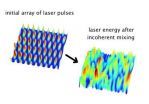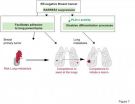(Press-News.org) WASHINGTON D.C., May 27, 2014 -- It took every inch of the Large Hadron Collider's 17-mile length to accelerate particles to energies high enough to discover the Higgs boson. Now, imagine an accelerator that could do the same thing in, say, the length of a football field. Or less.
That is the promise of laser-plasma accelerators, which use lasers instead of high-power radio-frequency waves to energize electrons in very short distances. Scientists have grappled with building these devices for two decades, and a new theoretical study predicts that this may be easier than previously thought.
The authors are Carlo Benedetti, Carl Schroeder, Eric Esarey, and Wim Leemans, physicists at Lawrence Berkeley National Laboratory's Berkeley Lab Laser Accelerator (BELLA) Center. Their paper, "Plasma wakefields driven by an incoherent combination of laser pulses: A path towards high-average power laser-plasma accelerators," appears in the May Special Issue of Physics of Plasmas, from AIP Publishing.
If their models prove correct, they could help lower the cost of high-energy physics research -- the Large Hadron Collider cost $9 billion -- as well as many other industrial and medical applications of accelerators.
Laser-plasma accelerators work by blasting a powerful laser beam into a plasma, a cloud of unattached electrons and ions.
"The effect is like the wake of boat speeding down a lake. If the wake was big enough, a surfer could ride it," Leemans, who heads the BELLA Center, explained.
"Imagine that the plasma is the lake and the laser is the motorboat. When the laser plows through the plasma, the pressure created by its photons pushes the electrons out of the way. They wind up surfing the wake, or wakefield, created by the laser as it moves down the accelerator," he said.
The fast moving electrons leave the heavy ions behind. As they separate, they create gigantic electric fields, 100 to 1,000 times larger than those in conventional accelerators.
This is how they accelerate electrons so rapidly. For example, Stanford's Linear Accelerator Center takes two miles to drive an electron to 50 billion electron volts (GeV). Leemans' experimental laser-plasma accelerator takes electrons to more than 1 GeV in slightly more than 1 inch.
It takes a lot of laser power to generate a wakefield. For example, BELLA's petawatt (1 quadrillion watts) laser has a 10 meter x 10 meter footprint. It generates 400 times more power than all the world's power plants combined, though only for 40 femtoseconds (40 quadrillionths of a second).
Unfortunately, it takes BELLA's laser a full second to recharge and send a second pulse. High-energy physics research requires tens of thousands of pulses per second. Many other applications would benefit from multiple pulses per second.
BELLA's laser has the highest repetition rate of any petawatt laser in the world. Building a faster petawatt laser would require a heroic feat of engineering.
Several European researchers have suggested using an array of smaller lasers to produce one enormous pulse. Since less powerful lasers recharge faster, they could produce hundreds or even thousands of pulses per second and sustain a wakefield over many meters.
The hurdle they needed to overcome was how to synchronize hundreds of lasers so they all pulsed within less than a femtosecond of one another.
Such precision would be expensive and presents serious technical problems. But the concept of combining lasers got Leemans' team thinking.
What if the beam was not perfect? What if it were just good enough to rapidly raise the photon pressure on the electrons? Could we get away with it, they wondered.
According to the model presented in Physics of Plasmas, they could. Leemans compares it to pushing a swing.
"Instead of one big push, we would give it many smaller pushes at roughly the same time. It's not quite perfect, but the swing doesn't really care. It averages over all these little pushes and up it goes."
Laxer timing would make larger and more sustainable accelerators practical. Leemans hopes to power them with a new technology based on highly-efficient fiber lasers. The power that off-the-shelf welding lasers offer demonstrates multi-kW capabilities but much work is needed to pack the power into ultrashort pulses needed for laser plasma accelerators. The paper offers an approach that gets us a step closer.
The new accelerators would offer new options to physicists trying to unravel how the universe is put together. It could lower the cost of industrial uses, and make high-energy accelerators more affordable for hospitals.
Just think of it as dreaming big by thinking small.
INFORMATION:
The article "Plasma wakefields driven by an incoherent combination of laser pulses: a path towards high-average power laser-plasma accelerators" is authored by C. Benedetti, C. B. Schroeder, E. Esarey, and W. P. Leemans. Published in the journal Physics of Plasmas on May 27, 2014, it will be available after that date at: http://scitation.aip.org/content/aip/journal/pop/21/5/10.1063/1.4878620
ABOUT THE JOURNAL
Physics of Plasmas, produced by AIP Publishing with the cooperation of the American Physical Society (APS) Division of Plasma Physics, is devoted to original experimental and theoretical contributions to the physics of plasmas. See: http://pop.aip.org
Smaller accelerators for particle physics?
In the future, combining lasers could shrink particle accelerators from kilometers to meters
2014-05-27
ELSE PRESS RELEASES FROM THIS DATE:
New epilepsy treatment offers 'on demand' seizure suppression
2014-05-27
A new treatment for drug-resistant epilepsy with the potential to suppress seizures 'on demand' with a pill, similar to how you might take painkillers when you feel a headache coming on, has been developed by UCL (University College London) researchers funded by the Wellcome Trust.
The treatment, described in Nature Communications, combines genetic and chemical approaches to suppress seizures without disrupting normal brain function. The technique was demonstrated in rodents but in future we could see people controlling seizures on-demand with a simple pill.
Epilepsy ...
Light-colored butterflies and dragonflies thriving as European climate warms
2014-05-27
Butterflies and dragonflies with lighter colours are out-competing darker-coloured insects in the face of climate change.
In a new study published in Nature Communications, scientists from Imperial College London, Philipps-University Marburg and University of Copenhagen have shown that as the climate warms across Europe, communities of butterflies and dragonflies consist of more lighter coloured species. Darker coloured species are retreating northwards to cooler areas, but lighter coloured species are also moving their geographical range north as Europe gets warmer.
For ...
Climate warming favors light-colored insects in Europe
2014-05-27
Climate changeButterflies and dragonflies with a lighter shade of colour do better in warmer areas of Europe. This gives them a competitive advantage over the darker insects in the face of climate change. Changes in Europe's insect assemblages due to warming can already be seen for dragonflies, shows a study recently published in Nature Communications.
"When studying biodiversity, we lack general rules about why certain species occur where they do. With this research we've been able to show that butterfly and dragonfly species across Europe are distributed according to ...
Why are girl babies winning in the battle for survival?
2014-05-27
Sexual inequality between boys and girls starts as early as in the mother's womb – but how and why this occurs could be a key to preventing higher rates of preterm birth, stillbirth and neonatal death among boys.
A team from the University of Adelaide's Robinson Research Institute has been studying the underlying genetic and developmental reasons why male babies generally have worse outcomes than females, with significantly increased rates of pregnancy complications and poor health outcomes for males.
The results - published today in the journal Molecular Human Reproduction ...
Medical mechanics
2014-05-27
Removing a malignant tumor from the head of the pancreas is a risky and demanding operation. The surgeon must carefully navigate around the stomach, the gallbladder, the bile duct, lymph nodes, and several high-pressure blood vessels.
But an inexpensive device designed by Harvard engineering students and a surgeon at Beth Israel Deaconess Medical Center offers surgeons a confident grip throughout the delicate procedure. The gentle grasper, equipped with rubberized pressure sensors, has three slender fingers that can slip through a very small incision and tease cancerous ...
Just look, but don't touch: EMA terms of use for clinical study data are impracticable
2014-05-27
The European Medicines Agency (EMA) receives comprehensive clinical study data from drug manufacturers. These data form the basis for the decision on the approval of new drugs. To make this information available to researchers and decision-makers, EMA issued a draft policy in 2013 for the publication of clinical study data, in which extensive data transparency was planned.
Besides other interested parties, the German Institute for Quality and Efficiency in Health Care (IQWiG) was intensely involved in the subsequent consultations. The result of these consultations is ...
The future of sweet cherry in Australia
2014-05-27
AUSTRALIA -- Predicted variations in global climates have fruit producers trying to determine which crops are best suited to weathering future temperature changes. Extreme high-temperature events are expected to become more frequent, and predictive models suggest that the global mean surface air temperature will rise by as much as two degrees by the middle of the 21st century. Higher temperatures could have an impact on the duration of critical "winter chill" periods needed for successful fruit production, potentially altering growing strategies. According to the authors ...
Differences in phenolic makeup of indigenous rose species and modern cultivars
2014-05-27
LJUBLJANA, SLOVENIA – The leaves and petals of roses are valued for their medicinal and aesthetic uses around the world. A new study identified specific phenolic compounds found in the petals of indigenous rose species and compared them with the phenolic profiles of modern rose cultivars to determine differences in the makeup of roses traditionally used for medicinal purposes and those varieties cherished for aesthetic qualities. According to the results, distinct differences exist in the distribution of leaf phenolic compounds, especially between indigenous rose species ...
Researchers identify a new suppressor of breast metastasis to the lung
2014-05-27
A study published today in EMBO Molecular Medicine reveals that the loss of function of the gene RARRES3 in breast cancer cells promotes metastasis to the lung.
The research, headed by Roger Gomis, ICREA Professor at the Institute for Research in Biomedicine (IRB Barcelona), is the result of a collaboration between two IRB labs and Joan Massagué, at the Memorial Sloan Kettering Cancer Center in New York.
The scientists demonstrate that RARRES3 is suppressed in estrogen receptor-negative (ER-) breast cancer tumours, thus stimulating the later invasion of the cancer cells ...
The science of school lunch
2014-05-27
In terms of ambience, Charlotte Central's cafeteria is -- well, conjure up your own elementary school lunch experience. There's more than one reason to run to recess. But on a recent visit to observe a group of researchers from UVM's Johnson Lab, the lunch ladies were serving up something more likely to be found on a restaurant menu: risotto with mushrooms and peas. It's the result of a host of programs by schools around Vermont to offer more tempting choices -- with locally sourced ingredients when possible, including herbs and vegetables from the playground garden -- ...
LAST 30 PRESS RELEASES:
Making lighter work of calculating fluid and heat flow
Normalizing blood sugar can halve heart attack risk
Lowering blood sugar cuts heart attack risk in people with prediabetes
Study links genetic variants to risk of blinding eye disease in premature infants
Non-opioid ‘pain sponge’ therapy halts cartilage degeneration and relieves chronic pain
AI can pick up cultural values by mimicking how kids learn
China’s ecological redlines offer fast track to 30 x 30 global conservation goal
Invisible indoor threats: emerging household contaminants and their growing risks to human health
Adding antibody treatment to chemo boosts outcomes for children with rare cancer
Germline pathogenic variants among women without a history of breast cancer
Tanning beds triple melanoma risk, potentially causing broad DNA damage
Unique bond identified as key to viral infection speed
Indoor tanning makes youthful skin much older on a genetic level
Mouse model sheds new light on the causes and potential solutions to human GI problems linked to muscular dystrophy
The Journal of Nuclear Medicine ahead-of-print tip sheet: December 12, 2025
Smarter tools for peering into the microscopic world
Applications open for funding to conduct research in the Kinsey Institute archives
Global measure underestimates the severity of food insecurity
Child survivors of critical illness are missing out on timely follow up care
Risk-based vs annual breast cancer screening / the WISDOM randomized clinical trial
University of Toronto launches Electric Vehicle Innovation Ontario to accelerate advanced EV technologies and build Canada’s innovation advantage
Early relapse predicts poor outcomes in aggressive blood cancer
American College of Lifestyle Medicine applauds two CMS models aligned with lifestyle medicine practice and reimbursement
Clinical trial finds cannabis use not a barrier to quitting nicotine vaping
Supplemental nutrition assistance program policies and food insecurity
Switching immune cells to “night mode” could limit damage after a heart attack, study suggests
URI-based Global RIghts Project report spotlights continued troubling trends in worldwide inhumane treatment
Neutrophils are less aggressive at night, explaining why nighttime heart attacks cause less damage than daytime events
Menopausal hormone therapy may not pose breast cancer risk for women with BRCA mutations
Mobile health tool may improve quality of life for adolescent and young adult breast cancer survivors
[Press-News.org] Smaller accelerators for particle physics?In the future, combining lasers could shrink particle accelerators from kilometers to meters




